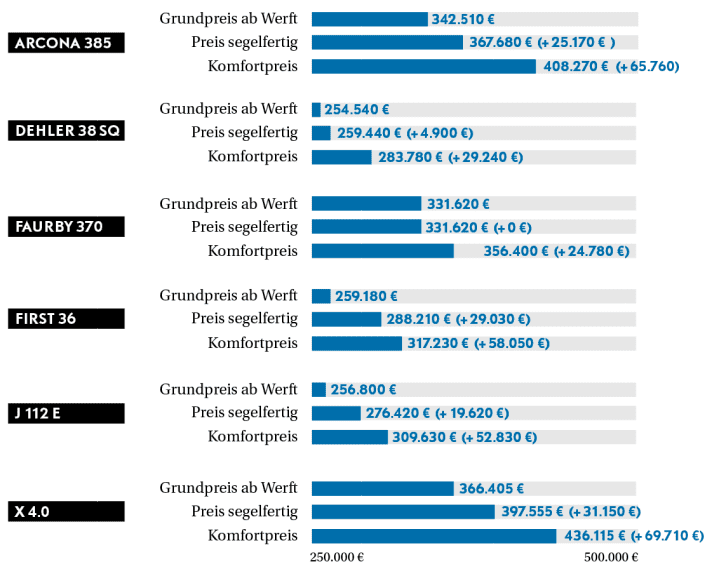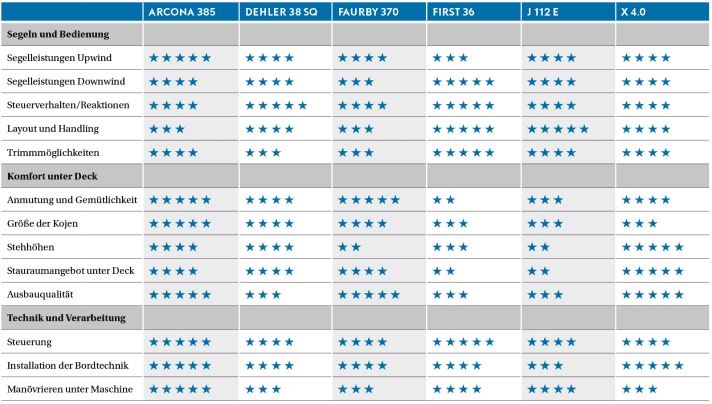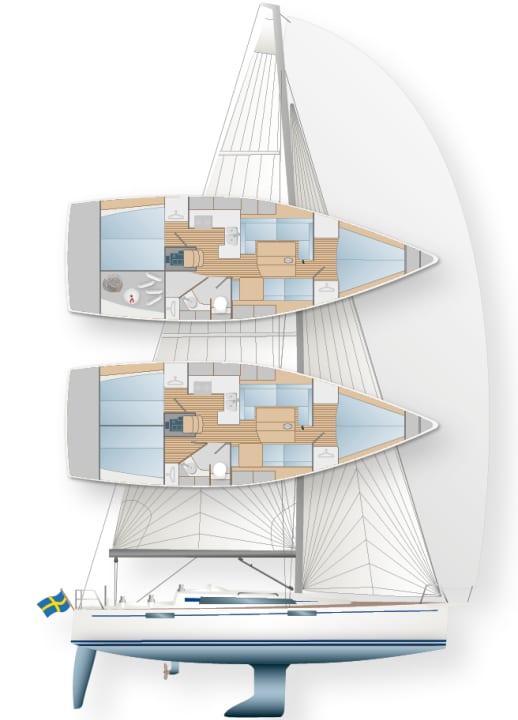Performance cruiser part 4: The final results of the comparison test

In the test:
- Arcona 385
- Dehler 38 SQ
- Faurby 370
- First 36 from Beneteau
- J 112 E
- X 4.0
The other parts of the performance cruiser comparison
A comparison of six current performance cruisers with a hull length of around eleven metres: never before has the YACHT editorial team organised, conducted and produced a group test in such detail. In the last three episodes, we looked at the sailing characteristics of the boats, the handling, the trim options, the comfort below deck and the storage space on offer - among many other topics. We also assessed the quality of the construction and fittings as well as the quality of the technical installations.
Now, in the fourth and final part, we analyse the comparative price structures and, of course, the decisive questions: Which is the best offer in the comparison and for whom? And: Does a clearly superior group winner emerge from the tests?
The prices
But first to the prices. These are listed for each boat in the comparison in the same way as in the YACHT individual tests. This means that, starting from the base price, all individual items are added up to the price for the clear sailing boat and then to the price for the comfortably equipped yacht. These surcharges are based on the scope of equipment defined by YACHT.
Within the test group, the basic prices ex shipyard already show a fairly clear division between the offers. The boats from the Scandinavian shipyards, i.e. the Arcona 385 from Sweden, the Faurby 370 and the X 4.0 (both from Denmark), have base prices at a comparable, but also significantly higher level of around 350,000 euros. In contrast, the competitors from Germany and France (Dehler 38 SQ, Beneteau First 36 and J 112 E) are priced significantly lower ex shipyard at around 250,000 euros and therefore around 100,000 euros cheaper. That makes a huge difference and splits the group.

The reasons for the wide range of base prices are partly to be found in the construction methods, the detailed workmanship and the production processes. In the small series productions of Arcona and Faurby, for example, the yachts are customised and largely built by hand, especially the interiors. This means more effort, more labour, more material costs and therefore higher production prices. The J 112 E, for example, and even more so the Dehler 38 SQ, come from larger product series, some of which are produced on an assembly line. The production processes are also already largely automated. This allows the shipyards to save costs and offer their products more cheaply. However, this is often accompanied by certain deficits in quality. Simply comparing the basic prices is not enough - as is almost always the case.
The equipment is decisive
What is more exciting is how the prices for the equipment adjustment (price ready to sail and comfort price) develop in comparison. Here, too, the gap between the offers is quite wide. The Faurby 370 comes as standard in a completely ready-to-sail version according to the YACHT definition. This means with a simple set of upwind sails (main and genoa) as well as a coat of antifouling as the most cost-intensive items. And the handover to the owners is also free of charge at Faurby. Accordingly, the additional costs up to the comfort price remain within a manageable range. Despite the relatively high base price, the Faurby shipyard in Denmark offers an attractive and complete range for its 370 with the lowest surcharges within the test group.
Dehler charges 254,540 euros for the 38 SQ, the lowest base price in the comparison. Remarkably, a (albeit not high-quality) set of Amwind sails is already included in the basic equipment ex shipyard. This means that the extra costs up to the ready-to-sail configuration remain equally low. On balance and in comparison, buyers generally have to dig the least deep into their pockets for a Dehler 38 SQ, even after the equipment adjustment. It is the cheapest boat in the test field.
The most expensive boat in the comparison fleet, on the other hand, is the X 4.0 from Denmark. With a base price of 366,400 euros, it is even more expensive than the equally exclusive offerings from the Scandinavian competitors Arcona and Faurby. The surcharges for the equipment adjustment up to the ready-to-sail price or the comfort price are also higher. Compared to the generally favourable Dehler 38 SQ, an X 4.0 with full equipment costs over 150,000 euros more.
For the Arcona 385, the First 36, the J 112 E and the X 4.0, the sails are only available for a significant surcharge, which is generally the case with performance cruisers. However, the shipyard and dealer information available to us varies quite widely. Mainsails and genoas in various qualities are available in a price range from just under €10,000 for the J 112 E to over €18,000 for the X 4.0. However, sailors with sporting ambitions know that you usually have to fork out considerably more money for a regatta-capable sail inventory if you want to equip the boats with high-quality membrane sails, additional gennakers in various sizes and a Code Zero. The cost of a good wardrobe quickly adds up to 30,000 euros or even more for a boat of this size, with almost no upper limit. Seen in this light, the cost of the sails also dilutes the information in the comparative price overview. We have summarised this in a compact form and it is listed at the end of the article for each boat.

And who will win now?
A clear winner across all test criteria still cannot be determined at the very end and ultimately taking into account the prices. The concepts, compromises and orientations are just too different. Anyone interested in the performance cruiser class with a hull length of around eleven metres can find their dream boat in all six yachts in the comparison, but they must make a selection in advance and set the priorities for their own personal requirements. And the price naturally also plays an important role in the selection process.
First 36 and J 112 E for sportiness
Sailors who have higher sporting demands and for whom success on the regatta course is ultimately more important than living comfort, cosiness and suitability for touring will get their money's worth with the First 36 from Beneteau and the J 112 E. The two French boats are primarily designed for good performance under sail, impress with perfect cockpit layouts for active regatta athletes, and they are also excellently equipped for racing right from the shipyard. The weight of these two boats is also important. Compared to the competition, both the First and the J are built quite consistently light, which is also reflected in a rather modest level of comfort below deck.
Arcona 385 and Faurby 370 for living comfort
The Arcona 385 from Sweden and the Faurby 370 from Denmark, on the other hand, are particularly appealing with their beautiful, high-quality interiors. If you want to live in uncompromising comfort while travelling and at the same time enjoy the best quality workmanship, these boats from Scandinavia are the perfect choice.
The fact that the two beautiful and timelessly designed yachts also have very good sailing characteristics and the potential to win regattas is a welcome side effect. This is particularly true of the Arcona 385, which is a newcomer to the Swedish regatta scene this year. However, buyers generally have to dig deeper into their pockets for the upmarket offerings from the north.
Dehler 38 SQ and X 4.0 for the middle way
Meanwhile, the German Dehler 38 SQ and the Danish X 4.0 find the perfect middle ground across most of the test criteria. Despite their equally strong performance under sail and winning potential, they are not ultimately focused on regatta-capable sportiness, as is the case with the Frist or the J. However, their successful interiors and on-deck designs are also suitable for comfortable cruising with the family or even with a small crew. In terms of price, however, there is a world of difference between the affordable Dehler 38 SQ and the expensive X 4.0.
The performance cruiser class with a hull length of around eleven metres is not only particularly attractive due to the good formats suitable for everyday use and is therefore also very well represented. The range on offer is correspondingly broad, which is impressively documented by the test selection in this comparison. This means that every potential buyer should be able to find a boat to suit their taste, sailing style and budget.
The prices in detail
Arcona 385

The Swede is convincing under sail and scores highly in terms of interior fittings and, above all, the quality of workmanship. It also plays a pioneering role in terms of technical installations. Seen in this light, it can combine many advantages and is one of the best in the comparison in a number of test criteria.
Equipment and prices
- Base price ex shipyard € 342,510
- Standard equipment included: engine, sheets, railing, navigation lights, battery, compass, cushions, galley/cooker, bilge pump, toilet, sailcloth, anchor with
- Chain, fenders/ mooring lines, fire extinguisher, electric cooler, holding tank with suction system
- For an extra charge: sails (main and genoa) € 16,090, antifouling € 3,760, clear sailing handover € 5,320
- Price ready to sail € 367,680
- Warranty/against osmosis 2/2 years
Surcharge for comfort equipment
- Hole points incl. line adjustment.
- Traveller with line guide incl.
- Electric windlass € 5,450
- Tube kicker incl.
- Backstay tensioner incl.
- Jumping cleats incl.
- Sprayhood incl.
- Teak in the cockpit € 14,790
- VHF radio package
- Log, plumb bob, wind display package
- Autopilot package
- Electrical package € 14,640
- Charger incl.
- Shore connection with RCD incl.
- 230 volt socket (one) incl.
- 12-volt socket in the sat nav incl.
- Heating € 4,640
- Pressurised water system incl.
- Hot water boiler incl.
- Shower WC room incl.
- Cockpit shower € 1,070
- Comfort price € 408,270
Dehler 38 SQ

The boat from Greifswald is conceptually balanced and willing to compromise. Comfort below deck, a cosy ambience and high functionality in the interior fittings appear to be at least as important as the good sailing characteristics. In terms of interior quality, the Dehler loses out to the boats from Scandinavia.
Equipment and prices
Base price ex shipyard € 254,540
- Standard equipment included: engine, sails (main and genoa), sheets, railing, position lanterns, battery, compass, cushions, galley/cooker, bilge pump, toilet, electric cooler, waste holding tank with suction system
- For an extra charge: sailcloth €1,180, anchor with chain €500, fenders/mooring €300, fire extinguisher €55, antifouling €2,045, clear sailing handover €820
- Price ready to sail € 259,440
- Warranty/against osmosis 2/5 years
Surcharge for comfort equipment
- Hole points incl. line adjustment.
- Traveller with line guide incl.
- Electric windlass € 2,130
- Tube kicker incl.
- Backstay tensioner incl.
- Jumping cleats € 1,180
- Sprayhood € 2,605
- Teak in cockpit incl.
- VHF radio package
- Log, plumb bob, wind display package
- Autopilot package
- Electrical package € 13,435
- Charger incl.
- Electrical package incl.
- Shore connection with RCD incl.
- 230 volt socket (one) incl.
- 12-volt socket in the sat nav incl.
- Heating € 4,990
- Pressurised water system incl.
- Hot water boiler incl.
- Shower WC room incl.
- Cockpit shower incl.
- Comfort price € 283,780
Faurby 370

She represents classic yacht building within the test group with a slim, but also somewhat conservative hull shape and a beautifully built, but also traditional-looking interior. Faurby also offers maximum individuality, as the boat can be built and customised entirely according to the owner's wishes.
Equipment and prices
Base price ex shipyard € 331,620
- Standard equipment included: engine, sails (main and genoa), sheets, railing, position lanterns, battery, compass, cushions, galley/cooker, bilge pump, toilet, sailcloth, anchor with chain, fenders/ mooring lines, fire extinguisher, electric cooler, holding tank with suction, antifouling,
- clear sailing handover
- For an extra charge: -
- Price ready to sail € 331,620
- Warranty/against osmosis 2/5 years
Surcharge for comfort equipment
- Line adjustable Hole points 980 €
- Traveller with line guide incl.
- Electric windlass € 6,230
- Tube kicker incl.
- Backstay tensioner incl.
- Jumping cleats incl.
- Sprayhood incl.
- Teak in cockpit incl.
- VHF radio € 1,940
- Log, plumb bob, wind indicator € 2,445
- Autopilot € 6,580
- Charger incl.
- Electrical package incl.
- Shore connection with RCD incl.
- 230 volt socket (one) incl.
- 12-volt socket in the sat nav incl.
- Heating € 5,825
- Pressurised water system incl.
- Hot water boiler incl.
- Shower WC room incl.
- Cockpit shower 780 €
- Comfort price € 356,400
First 36

The stark contrast to the Faurby. The new ship from Beneteau's sporty First series follows an ultra-modern concept. The interior is functionally reduced and at the same time very light. Nevertheless, it is not uncomfortable inside. Under sail, the sporty Frenchwoman with the wide stern is particularly fast on the beam.
Equipment and prices
- Base price ex shipyard € 259,180
- Standard equipment included: engine, sheets, railing, navigation lights, battery, compass, cushions, galley/cooker, bilge pump, toilet, fire extinguisher, electric cooler, holding tank with suction system
- At extra cost: sails (main and genoa) €12,800, sailcloth €1,280, anchor with chain €4,430, fenders/mooring €320,
- Antifouling € 7,000, clear sailing handover € 3,200
- Price ready to sail € 288,210
- Guarantee/against osmosis 7/7 years
Surcharge for comfort equipment
- Hole points incl. line adjustment.
- Traveller with line guide incl.
- Electric windlass incl. (with anchor) tube kicker € 660
- Backstay tensioner incl.
- Jumping cleats incl.
- Sprayhood € 2,900
- Teak in the cockpit in preparation
- VHF radio package
- Log, plumb bob, wind display package
- Autopilot package
- Package € 18,200
- Charger incl.
- Shore connection with RCD incl.
- 230 volt socket (one) incl.
- 12-volt socket in the sat nav incl.
- Heating € 5,640
- Pressurised water system incl.
- Hot water boiler € 1,430
- Shower WC room incl.
- Cockpit shower 190 €
- Comfort price € 317,230
J 112 E

Sportiness and high performance are also the focus of the French-built American. With her very long, extendable bowsprit and large steering wheel, she is exceptional in comparison. The interior is attractively finished, but there is criticism for the uncleanly installed on-board technology.
Equipment and prices
- Base price ex shipyard € 256,800
- Standard equipment included: engine, sheets, railing, navigation lights, battery, compass, cushions, galley/cooker, bilge pump, toilet, anchor with chain, fender/mooring, electric cooler, holding tank with suction system
- For an extra charge: sails (main and genoa) € 9,390, sailcloth € 565, fire extinguisher € 145, antifouling € 5,710, clear sailing handover € 3,810
- Price ready to sail € 276,420
- Guarantee/against osmosis 2/10 years
Surcharge for comfort equipment
- Hole points incl. line adjustment.
- Traveller with line guide incl.
- Electric windlass € 3,930
- Tube kicker incl.
- Backstay tensioner incl.
- Jumping cleats incl.
- Sprayhood € 2,475
- Teak in the cockpit € 6,555
- VHF radio € 1,000
- Log, plumb bob, wind indicator € 1,680
- Autopilot € 6,085
- Charger € 1,030
- Shore connection with RCD incl.
- 230 volt socket (one) incl.
- 12-volt socket in the sat nav incl.
- Heating € 8,310
- Pressurised water system incl.
- Hot water boiler € 1,715
- Shower WC room incl.
- Cockpit shower € 430
- Comfort price € 309,630
X 4.0

Simply good. The beautiful Dane combines visual appeal with solid sailing characteristics, a well thought-out layout on deck and a very beautiful, high-quality interior. The equipment also demonstrates X-Yachts' many years of experience in building performance cruisers. Only her high weight dampens the enthusiasm somewhat.
Equipment and prices
- Base price ex shipyard € 366,405
- Standard equipment included: engine, sheets, railing, navigation lights, battery, compass, cushions, galley/cooker, bilge pump, WC, anchor with chain, fenders/ mooring lines, fire extinguisher, electric cooler,
- Faeces tank with suction
- At extra cost: Sail (main and genoa) € 18,280, sailcloth € 1,305, antifouling
- 6,700 €, clear sailing handover 4,865 €
- Price ready to sail € 397,555
- Warranty/against osmosis 2/5 years
Surcharge for comfort equipment
- Line adjustable Hole points 6.490 €
- Traveller with line guide incl.
- Electric windlass € 4,240
- Tube kicker incl.
- Backstay tensioner incl.
- Jumping cleats 460 €
- Sprayhood € 4,880
- Teak in cockpit incl.
- VHF radio € 2,075
- Log, plumb bob, wind indicator € 5,570
- Autopilot € 8,730
- Charger incl.
- Shore connection with RCD incl.
- 230 volt socket (one) incl.
- 12-volt socket in the sat nav incl.
- Heating € 6,115
- Pressurised water system incl.
- Hot water boiler incl.
- Shower WC room incl.
- Cockpit shower incl.
- Comfort price € 436,115
The other parts of the performance cruiser comparison

